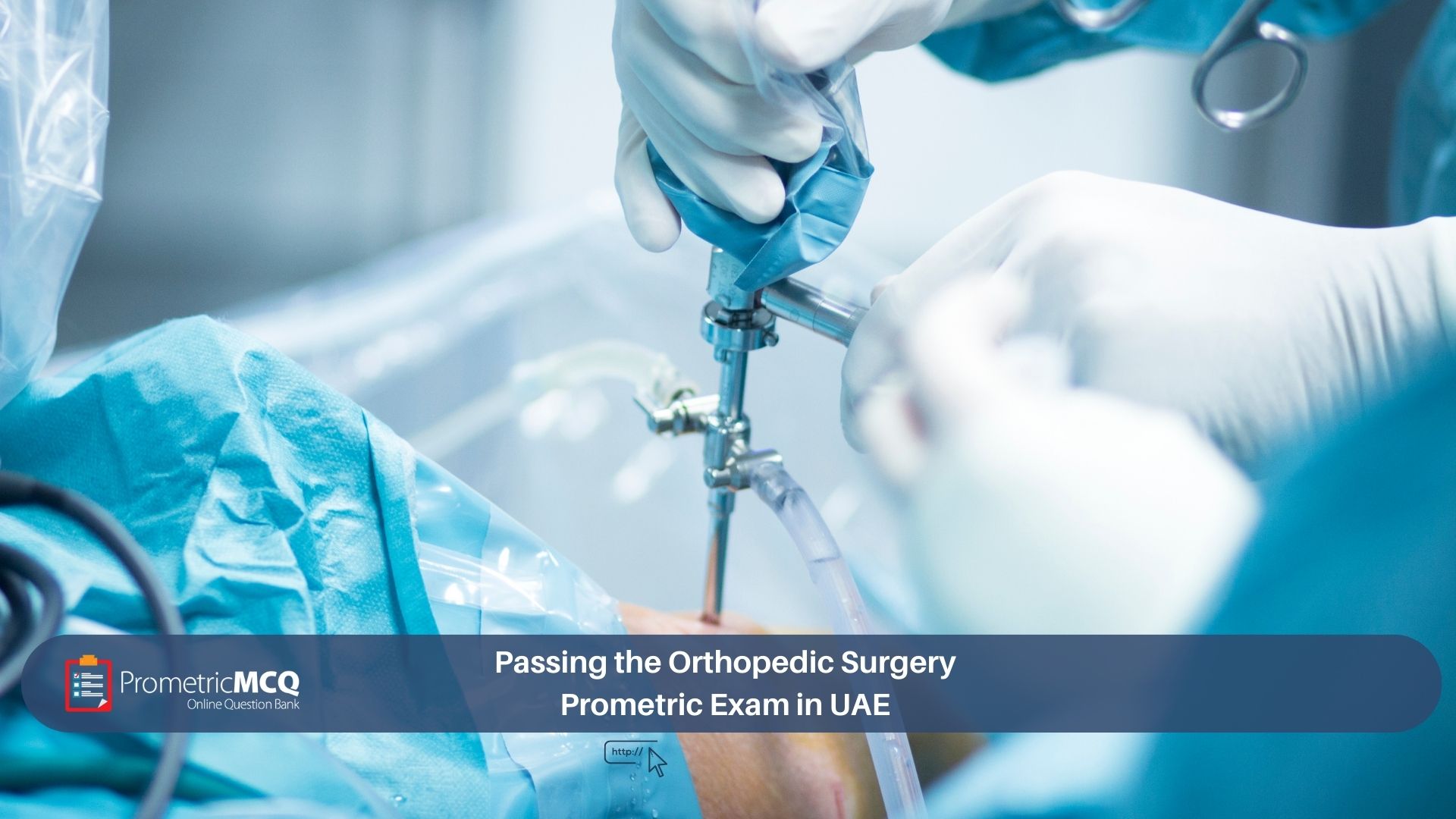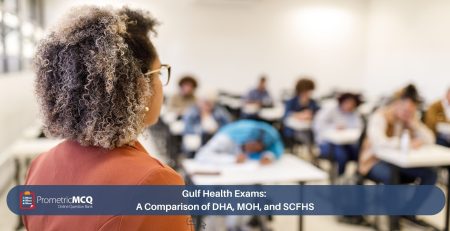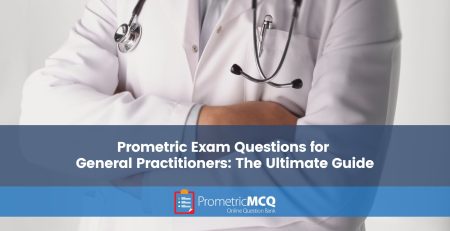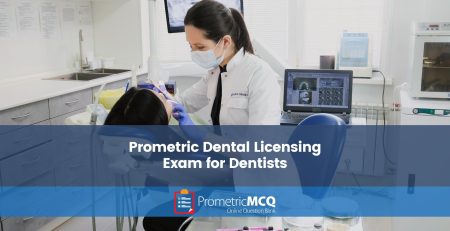
Passing the Orthopedic Surgery Prometric Exam in UAE
fatima@prometricmcq.com2025-09-30T00:52:29+00:00Table of Contents
TogglePassing the Orthopedic Surgery Prometric Exam in UAE (2025 Guide)
The United Arab Emirates has firmly established itself as a global leader in healthcare, with a particular focus on specialized surgical disciplines like Orthopedics. The nation’s investment in cutting-edge hospitals and sports medicine facilities creates a compelling environment for orthopedic surgeons seeking a dynamic and advanced career. To ensure the highest standards of care, all surgeons must pass a rigorous licensure exam administered by Prometric on behalf of the local health authorities, primarily the Dubai Health Authority (DHA) and the Ministry of Health and Prevention (MOHAP).
The UAE’s Orthopedic Surgery Prometric exam is a formidable challenge, designed to assess a deep, specialist-level understanding of the field. This is not a test of general medical knowledge; it is a sophisticated, case-based examination that probes your ability to diagnose complex musculoskeletal conditions, formulate evidence-based surgical plans, and manage potential complications. The Multiple-Choice Questions (MCQs) are crafted to test advanced clinical reasoning, requiring a thorough knowledge of anatomy, biomechanics, and the latest international surgical guidelines.
This ultimate 2025 guide is your comprehensive blueprint for mastering the Orthopedic Surgery Prometric exam in the UAE. We will dissect the exam’s pattern, provide a deep dive into the high-yield syllabus domains from trauma to arthroplasty, and offer a series of challenging, exam-style questions with detailed, guideline-based rationales. To ensure complete clarity, a robust 10-point FAQ section will address the most common questions and concerns for orthopedic specialists. This is your definitive resource for passing the exam and securing your license to practice in the UAE.
Key Takeaways for the Orthopedic Surgery Exam
- Trauma is the Main Event: A very large portion of the exam is dedicated to fracture management. Master the AO principles and key fracture classifications.
- Know Your Classifications: Be proficient with essential classifications (e.g., Garden for femoral neck, Lauge-Hansen for ankle, Salter-Harris for pediatric physeal fractures).
- Guideline-Driven Answers: Your choices must align with the latest international, evidence-based guidelines from bodies like the AAOS.
- Indications for Surgery are Key: A common question format asks you to decide between operative and non-operative management. Know the precise indications for surgery.
- Specialty-Specific MCQs are Crucial: Your success depends on intensive practice with a high-quality QBank tailored specifically to orthopedic surgery.
Deconstructing the UAE Orthopedic Surgery Exam: Pattern and Syllabus
Whether you are applying for a DHA license in Dubai or a MOH license for other Emirates, the Prometric exam format is standardized and rigorous.
Core Exam Framework
- Administrator: Prometric
- Format: Computer-Based Test (CBT) with 100% MCQs.
- Structure: Typically 150 MCQs.
- Duration: 2.5 hours (150 minutes).
- Scoring: A Pass/Fail result is given. The unofficial passing score for specialist exams is high, estimated to be in the 65-70% range. There is no negative marking.
High-Yield Syllabus Breakdown
The exam is designed to cover the full breadth of orthopedic surgery. A strategic preparation plan focuses on these key domains.
| Orthopedic Domain | High-Yield Topics and Key Concepts for 2025 |
|---|---|
| Orthopedic Trauma (~40-50%) | This is the most heavily tested domain. Upper Extremity: Distal radius fractures (classifications, management), scaphoid fractures, humeral shaft fractures (radial nerve palsy). Lower Extremity: Femoral neck and intertrochanteric fractures (Garden classification, surgical options), ankle fractures (Lauge-Hansen, Weber), tibial plateau and pilon fractures. Principles: AO principles of fracture fixation, management of open fractures (Gustilo-Anderson), and compartment syndrome. |
| Adult Reconstruction & Arthroplasty (~15-20%) | Management of hip and knee osteoarthritis. Indications for total hip arthroplasty (THA) and total knee arthroplasty (TKA). Surgical approaches for THA (posterior vs. anterior). Complications of arthroplasty (infection, dislocation, periprosthetic fractures). |
| Pediatric Orthopedics (~10-15%) | Developmental Dysplasia of the Hip (DDH – diagnosis and treatment), clubfoot (Ponseti method), Slipped Capital Femoral Epiphysis (SCFE), Legg-Calvé-Perthes disease, and management of common pediatric fractures, especially supracondylar humerus fractures (Gartland classification) and physeal injuries (Salter-Harris classification). |
| Spine Surgery (~10%) | Diagnosis and management of lumbar disc herniation and spinal stenosis. Workup of low back pain and recognition of “red flag” symptoms requiring urgent intervention (e.g., cauda equina syndrome). Basics of degenerative spondylolisthesis. |
| Sports Medicine & Arthroscopy (~10%) | Diagnosis and management of ACL tears, meniscal injuries, and rotator cuff tears. Physical examination tests (Lachman, McMurray, shoulder impingement tests). Basic principles of knee and shoulder arthroscopy. |
| Basic Sciences, Tumors, & Other (~5-10%) | Bone healing physiology, biomechanics of implants. Diagnosis and differentiation of benign bone tumors (e.g., osteochondroma) from malignant tumors (e.g., osteosarcoma, Ewing’s sarcoma). Foot and ankle conditions (e.g., hallux valgus, plantar fasciitis). |
High-Yield Orthopedic Surgery MCQs: Free Practice Questions
The following questions are designed to simulate the advanced clinical reasoning tested on the UAE Prometric exam. Analyze each case and its detailed rationale. For comprehensive preparation, a dedicated QBank of Orthopedic MCQs is your most critical study tool.
Question 1: Orthopedic Trauma
A 78-year-old female with osteoporosis falls at home and presents with a displaced femoral neck fracture. Radiographs show a Garden IV classification. What is the most appropriate surgical treatment for this patient?
- Cannulated screw fixation
- Dynamic Hip Screw (DHS)
- Hemiarthroplasty
- Intramedullary nailing
Correct Answer: C (Hemiarthroplasty)
Rationale: This question tests a cornerstone of orthopedic trauma management. A Garden IV femoral neck fracture is a completely displaced fracture. In an elderly patient with low physiological demand and poor bone quality (osteoporosis), the blood supply to the femoral head is almost certainly disrupted, leading to a very high risk of avascular necrosis (AVN) and non-union if fracture fixation (like screws or a DHS) is attempted. Therefore, the standard of care is to replace the femoral head. A hemiarthroplasty (replacing only the femoral side) is the most appropriate treatment as it is a durable procedure that allows for immediate weight-bearing, which is crucial for minimizing complications in elderly patients.
Why other options are incorrect:
A: Cannulated screws are only appropriate for undisplaced or minimally displaced (Garden I/II) fractures in patients of any age, or in very young patients with displaced fractures where preserving the native head is prioritized.
B: A DHS is used to treat intertrochanteric fractures, not intracapsular femoral neck fractures.
D: An intramedullary nail is also a treatment for intertrochanteric or subtrochanteric fractures, not femoral neck fractures.
Question 2: Pediatric Orthopedics
A 6-year-old boy falls from monkey bars directly onto his outstretched left arm and presents with significant elbow swelling and pain. A radiograph reveals a displaced supracondylar humerus fracture with posterior displacement of the distal fragment, but with the posterior cortex still in contact. According to the Gartland classification, what type of fracture is this, and what is the primary concern?
- Type I; concern for cubitus varus.
- Type II; concern for nerve or vascular injury.
- Type III; concern for compartment syndrome.
- Type IV; concern for avascular necrosis.
Correct Answer: B (Type II; concern for nerve or vascular injury.)
Rationale: The Gartland classification is essential for supracondylar fractures. Type I is non-displaced. Type II, as described here, is displaced but with the posterior cortex intact (an intact hinge). Type III is completely displaced with no cortical contact. This is a Type II fracture. Supracondylar humerus fractures are notorious for their risk of neurovascular injury due to the proximity of the brachial artery and the median, radial, and ulnar nerves to the fracture site. The anterior interosseous nerve (a branch of the median nerve) is the most commonly injured nerve. Therefore, a meticulous neurovascular exam is the most critical part of the initial assessment.
Why other options are incorrect:
A: Cubitus varus (gunstock deformity) is a potential late complication of malunion, not an immediate concern.
C: While compartment syndrome is a risk, the primary and most frequent immediate concern is direct injury to the neurovascular structures at the time of fracture.
D: AVN is not a common complication of this fracture.
Frequently Asked Questions (FAQs) for the Orthopedic Surgery Exam
The exam is graded Pass/Fail. The official score is not released, but the accepted unofficial passing threshold for a specialist exam like orthopedics is high, estimated to be between 65% and 70%.
The content and difficulty level are virtually identical as both are based on international standards of orthopedic practice. They cover the same syllabus and are administered by Prometric. A candidate prepared for one is prepared for the other. The main difference is the jurisdiction of the final license.
It is critically important. You must be fluent in the classifications that guide treatment. For example, knowing if a femoral neck fracture is a Garden I vs. a Garden IV completely changes the surgical plan. Focus on the classifications mentioned in the syllabus breakdown above, as they are the most high-yield.
Your preparation should be based on cornerstone orthopedic textbooks (e.g., *Rockwood and Green’s Fractures in Adults and Children*, *Campbell’s Operative Orthopaedics*) and, most importantly, the latest clinical practice guidelines from major bodies like the American Academy of Orthopaedic Surgeons (AAOS). The single most effective study tool is a high-quality, orthopedic-specific QBank.
Primary Source Verification (PSV) by DataFlow is a mandatory verification of your credentials (medical degree, residency/fellowship certificates, board certifications, and experience). A positive report is required by the DHA and MOH before your license to practice is issued.
While the exam is surgically focused, a significant number of questions will test your ability to determine when *not* to operate. You must know the indications for non-operative management of common conditions (e.g., specific fracture patterns, types of back pain, osteoarthritis).
No, the exam uses only generic names for all medications (e.g., “cefazolin,” not “Ancef”).
Most UAE health authorities allow three attempts to pass the specialist exam. A waiting period is required between attempts. A failure should be seen as an indication to invest in a more robust and question-based study strategy.
You should know the principles and major complications of common approaches (e.g., risk to the superior gluteal nerve in the anterolateral approach to the hip). You will not be asked about specific, proprietary implant designs but should understand the biomechanical principles of different implant types (e.g., locking plates vs. non-locking plates).
The Consultant exam is a higher-level assessment that assumes clinical mastery. It may include more questions on managing complex complications, revision surgery, rare conditions, and topics related to research, ethics, and departmental leadership.
Conclusion: Your Path to an Orthopedic Career in the UAE
The Prometric exam for Orthopedic Surgery in the UAE is a comprehensive and challenging test designed to certify a high level of specialist competence. It rewards a deep, evidence-based understanding of the field, particularly in the domain of trauma. By structuring your preparation around the high-yield topics, mastering the key classifications, and dedicating yourself to intensive practice with high-quality MCQs, you can confidently meet this challenge. Passing this exam is the definitive step toward a successful and rewarding career as an orthopedic surgeon in the UAE’s dynamic and advanced healthcare system.
Ready to Build Your Surgical Confidence and Ace the Exam?
Our comprehensive Orthopedic Surgery MCQ package is filled with high-yield, guideline-based clinical cases and detailed rationales designed to cover the entire DHA and MOH syllabus and ensure your success.










